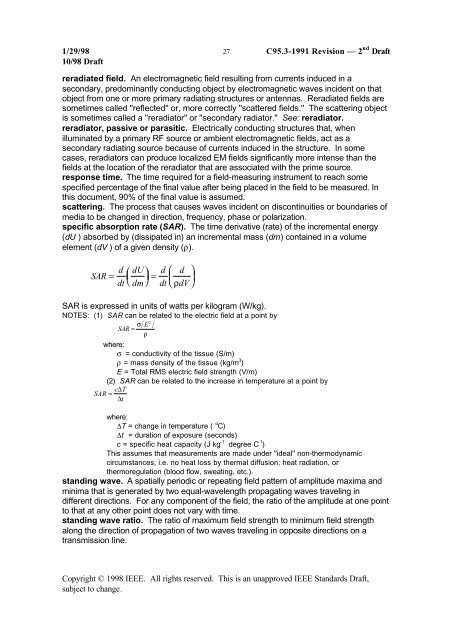DRAFT Recommended Practice for Measurements and ...
DRAFT Recommended Practice for Measurements and ...
DRAFT Recommended Practice for Measurements and ...
You also want an ePaper? Increase the reach of your titles
YUMPU automatically turns print PDFs into web optimized ePapers that Google loves.
1/29/98 27 C95.3-1991 Revision — 2 nd Draft<br />
10/98 Draft<br />
reradiated field. An electromagnetic field resulting from currents induced in a<br />
secondary, predominantly conducting object by electromagnetic waves incident on that<br />
object from one or more primary radiating structures or antennas. Reradiated fields are<br />
sometimes called ''reflected'' or, more correctly ''scattered fields.'' The scattering object<br />
is sometimes called a ''reradiator'' or ''secondary radiator.'' See: reradiator.<br />
reradiator, passive or parasitic. Electrically conducting structures that, when<br />
illuminated by a primary RF source or ambient electromagnetic fields, act as a<br />
secondary radiating source because of currents induced in the structure. In some<br />
cases, reradiators can produce localized EM fields significantly more intense than the<br />
fields at the location of the reradiator that are associated with the prime source.<br />
response time. The time required <strong>for</strong> a field-measuring instrument to reach some<br />
specified percentage of the final value after being placed in the field to be measured. In<br />
this document, 90% of the final value is assumed.<br />
scattering. The process that causes waves incident on discontinuities or boundaries of<br />
media to be changed in direction, frequency, phase or polarization.<br />
specific absorption rate (SAR). The time derivative (rate) of the incremental energy<br />
(dU ) absorbed by (dissipated in) an incremental mass (dm) contained in a volume<br />
element (dV ) of a given density (ρ).<br />
SAR =<br />
d<br />
dt<br />
⎛<br />
⎜<br />
⎝<br />
dU⎞<br />
⎟ =<br />
dm⎠<br />
d<br />
dt<br />
⎛ d ⎞<br />
⎜ ⎟<br />
⎝ ρdV⎠<br />
SAR is expressed in units of watts per kilogram (W/kg).<br />
NOTES: (1) SAR can be related to the electric field at a point by<br />
E<br />
SAR = σ 2<br />
| |<br />
ρ<br />
where:<br />
σ = conductivity of the tissue (S/m)<br />
ρ = mass density of the tissue (kg/m 3 )<br />
E = Total RMS electric field strength (V/m)<br />
(2) SAR can be related to the increase in temperature at a point by<br />
SAR = c∆T ∆t<br />
where:<br />
∆T = change in temperature ( o C)<br />
∆t = duration of exposure (seconds)<br />
c = specific heat capacity (J kg -1 degree C -1 )<br />
This assumes that measurements are made under ''ideal'' non-thermodynamic<br />
circumstances, i.e. no heat loss by thermal diffusion, heat radiation, or<br />
thermoregulation (blood flow, sweating, etc.).<br />
st<strong>and</strong>ing wave. A spatially periodic or repeating field pattern of amplitude maxima <strong>and</strong><br />
minima that is generated by two equal-wavelength propagating waves traveling in<br />
different directions. For any component of the field, the ratio of the amplitude at one point<br />
to that at any other point does not vary with time.<br />
st<strong>and</strong>ing wave ratio. The ratio of maximum field strength to minimum field strength<br />
along the direction of propagation of two waves traveling in opposite directions on a<br />
transmission line.<br />
Copyright © 1998 IEEE. All rights reserved. This is an unapproved IEEE St<strong>and</strong>ards Draft,<br />
subject to change.
















